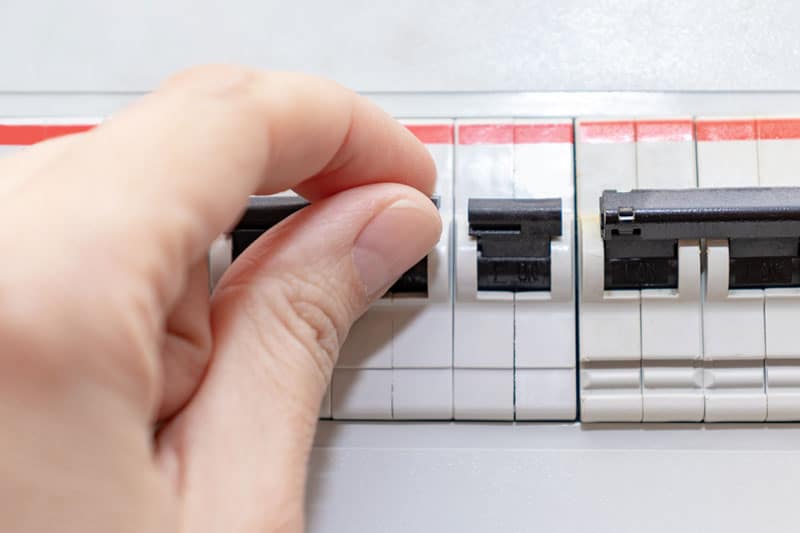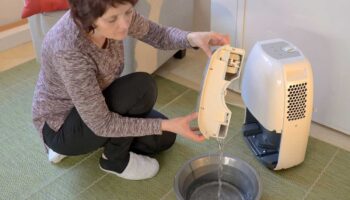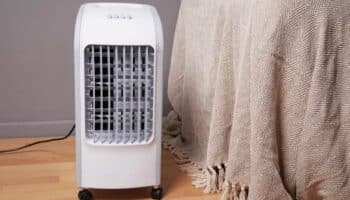We've independently reviewed this article to make sure it's as accurate as we can make it.
To find out more about our article creation and review process, check out our editorial guidelines.
Hot weather sucks, and what sucks even more, is an AC that keeps tripping your breaker and shutting off, leaving you all vulnerable to the sweltering heat.
However, as annoying and intimidating as it can be, it is meant to protect you! Yes, you.
Circuit breakers act as safety switches to protect you and your family from fires, electrical shock, and other dangers related to over currents. That’s why I do not recommend resetting the breaker and allowing it to trip as it could harm the unit or, worse, cause fire.

Experts say there is only one reason why your portable air conditioner could trip your breaker–overloading, but that’s pretty outdated now, as there are multiple reasons why your circuit breaker can get so nasty in hot weather.
There could be a problem with the wiring, normal wear and tear on the breaker, dirty air filters in the AC, grounded compressor (the worst), dirty condenser coils, and many other reasons.
If you’ve tried solving the problem unsuccessfully, I assume it’s the reason why you’re here. Stick around as I will be discussing all the possible reasons why your AC could be tripping the breaker and include a detailed step by step solution, so you’re fully informed about what to check, where to check, and what to do whenever your circuit breaker trips.
Ready to crack this up? Let’s do it!
Common Causes of Air Conditioner Tripping the Breaker
Now, it’s crucial that you understand this. When an air conditioner trips the breaker, there are three major possible explanations— overloading, faulty AC, or damaged breaker.
It’s critical to rule out overloading before checking other possible causes by unplugging other devices using the same breaker and resetting the breaker. If it still trips, here are the possible problems with your AC and the possible solutions.
#1 Dusty Condenser Coils
Your AC comes with an interior and exterior unit. The condenser coils are in the exterior unit. The interior unit is designed to absorb heat from the air using the refrigerant and flow to the exterior unit to disperse the heat. When the condenser coils get dirty, they prevent the exterior unit from dispersing the heat outside, overworking the AC, forcing it to overheat and eventually trip the breaker.
How to fix it: You can try cleaning the coils yourself. Condenser coils in outside units can be easily accessed and gently hosed down to clean them. Just don’t use too much pressure.
#2 Not Enough Refrigerant
Older units, especially if you have not been servicing the unit, can develop corrosion on the coils, leading to holes and cracks leaking refrigerant. Like dirty air filters, when your air conditioner runs on less refrigerant, it has to work longer than usual to cool a room. This leads to overheating and more damage to your AC.
How to fix it: Move closer to your AC and place your hand above the AC. Listen to the sound the AC is making and feel if the air coming out is cold or warm. If it is noisier and releases hot or warm air, your refrigerant might be the problem. Have a technician come over to refill the refrigerant and seal up any leaks.
#3 Motor Shorted
If your circuit breaker has never tripped before, check whether you’ve been running the AC longer than usual. Electric motors in your AC can take a bit of abuse, but they won’t tolerate it for long. If the motor becomes too hot for too long, the insulation wire can break down, leading to an electrical short. Shorts happen when electricity bypasses its standard path, like taking the form of a “shortcut.”
This shortcut enables more electricity to flow than the wires can handle, causing the wires to overheat and melt and, of course, before the worst happens, the breaker trips!
How to fix it: Seek professional assistance to help locate the short and fix it.
#4 Compressor “Hard Starting.”
The compressor is the heart of your AC. It pulls lots of electricity when starting, but as it ages, it begins to have trouble starting up. When your compressor starts showing signs of hard starting, it uses more electricity to start and get going, thus tripping the breaker. That’s why you should avoid resetting the breaker, especially if you’re unsure what is wrong with your air conditioner.
How to fix it: Have your technician check your compressor and install a “hard start kit”–a capacitor that gives the old, tight, or weak compressor motor an extra electrical jolt to get it moving. However, if it’s older than ten years, I highly recommend replacing it as it might be too old or too damaged for repair.
#5 Grounded Compressor
This is the worst news you ever want to hear. A “grounded compressor” means that the electrical wiring inside the compressor has broken and hit the side of the compressor. This leads to a direct short in the ground, igniting the oil and causing burnout. As expected, it trips the circuit breaker due to the sudden current surge.
How to fix it: There is no going around it; you need to hire an AC technician to replace the compressor as soon as possible and clean the refrigerant lines. If your warranty does not cover the compressor or it has already expired, replace the entire exterior unit. It’s cheaper this way as compressors are pretty pricey.
#6 Loose Wiring and Aging Parts
If your AC is working overtime, it is susceptible to normal wear and tear. The wiring inside may start to loosen, and other parts may start showing signs of aging. If all is not well, the result is a breaker that trips frequently.
How to fix it: Apart from routine maintenance, you need to clean your AC once in a while, especially during summer when it can get dusty and run longer hours. Replace or repair worn-out parts and always find other natural ways of keeping your home cooler to allow your AC to rest.
If you want to get any replacement part – or see how much one would cost – click to enter your model number in the search bar below. Our partners at AppliancePartsPros stock almost every part with free guides on how to install them.

Check out some of the tips and guides I have posted to learn a few tricks you can incorporate to stay cooler without skyrocketing your energy bills.
5 Steps on How to Solve Portable AC That Keeps Tripping the Circuit Breaker
If you have checked the above causes and ruled them out, it’s time to move to the next necessary step and diagnose the problem. Generally, we’re going to begin by ruling out overloading and proceed to check whether your unit is functioning correctly before turning on the circuit breaker itself. Eventually, we will capture the culprit, so let’s begin!
Materials Needed
- Safety glasses
- Screwdrivers
- Flashlight
Step #1 Turn Off the Light Switches and Unplug All Appliances EXCEPT the Air Conditioner
If it’s the first time your circuit breaker is tripping with the AC on, turn off the lights and other devices except for the air conditioner. I know you must have tried doing this on your own, but it is critical to help rule out overloading.
Step #2 Find the Tripped Circuit Breaker
Go to the breaker box and find the problematic breaker. The lever will obviously be in the OFF position. Pull it to the ON position. If the breaker trips, the problem could be the unit or the circuit breaker.

Step #3 Turn OFF the AC Unit
Turn off the AC unit. If you’re dealing with a small unit like a portable or window air conditioner, try also keeping the other appliances on that circuit off. In other words, turn off everything using the problematic circuit breaker (for installed central/ductless units, these will have their own circuit). This is a crucial step to determine which appliance between the AC and the breaker is the culprit.
Step #4 Reset the Breaker
Feel the breaker to see if it’s hot, warm, or the same temperature as the other breakers. This will suggest if you have a slow overheating problem, or a fast trip that may not heat the breaker. This can help with troubleshooting the issue later.
In this step, you’ll need to flip the breaker switch to the OFF position and then back to the ON position. Check if the breaker trips.
Step #5 Wait 30 Minutes Before Turning on the AC
Give it roughly 30 minutes to see if it trips or not. Now, if it doesn’t trip, you should already have the culprit–the AC. It could be the wiring, normal wear and tear, or simply anything you overlooked. You might want to check your AC thoroughly or consider getting an expert to do it for you.
However, if the breaker trips almost immediately, you flip the lever, your focus should automatically shift to your circuit breaker. It is quite rare for a breaker to trip with nothing plugged in, but that doesn’t mean it can’t happen.
Step #6 Replace the Circuit Breaker
Breakers can trip for different reasons, so don’t replace your breaker blindly without assessing where the problem is coming from. Like any other device in your home, your breaker also gets damaged. Check for warning signs and replace your breaker if you notice the following:
- Scratch marks or signs of wear and tear
- A breaker that is older than ten years
- A burning smell coming from the electric box
- Breaker tripping frequently even when the AC is off
I do not recommend changing your breaker yourself, particularly if it is your first time handling a breaker. If you live in a rented home, your landlord may also be against it. While the entire process is quite easy, it is quite dangerous to deal with naked electric wires. Consider hiring a professional to change the breaker on your behalf and avoid trouble.
Final thoughts
Your AC tripping the breaker is a pretty common problem that you can quickly solve, depending on the extent of the problem. Don’t rush to call your electrician before attempting to open the breaker, reset it, or open the AC to see if there’s anything unusual. Some air conditioners simply need some cleaning to get them working optimally.
First, make sure your AC is in good condition, then look for signs of overloading before turning on the breaker itself using the steps I have provided.
I feel this post has covered everything about portable AC tripping the breaker, so you should feel like a pro already! Finally, if you feel that this information has helped you solve your tripping breaker, why not check some of our other related posts below? We believe every problem has a solution, and we’re part of that solution.







